Thalictrum L. (Ranunculaceae)
Thalictrum is represented by eight species in North Carolina. Two species species are currently listed: Thalictrum cooleyi (Fed E, S1 G1) and T. macrostylum (State SC-V, S2 G3G4).
Thalictrum is a difficult genus, requiring additional taxonomic study. Workers have held rather different taxonomic concepts (see Keener 1976 vs. Park & Festerling 1997). Several taxa—particularly T. pubescens and T. coriaceum—remain problematic (see Park 1992).
Note that Thalictrum species in general tend to be much more common in the mountains and Piedmont, than in the Coastal Plain.
Federally listed taxon—
Thalictrum cooleyi(Fed E, State E | S1 G1)
Habitat. Grass-sedge bogs, wet pine savannas.
Range. Endemic to SE Coastal Plain (FL, GA, NC).
Notes. Thalictrum represents a difficult genus in need of much additional population level research. A problem of particular interest to North Carolina workers, is the resolution of taxonomic issues in the T. revolutum-T. pubescens complex. Some authors have recognized multiple taxa in this complex, whereas others only few (see Weakley 2010 for more detailed discussion). Weakley (2010) decided to provisionally recognize T. pubescens var. hepaticum at the varietal level to draw attention to the problem--a decision followed here as well.
Additional resources. NHP | Recovery plan | 5-yr review
Key to Thalictrum in North Carolina
Key adapted from Radford et al. (1968) and Weakley (2008, 2010). Photos by Krings, unless otherwise indicated. Line drawings from Britton & Brown (1913). Maps courtesy of USDA PLANTS and the North Carolina Natural Heritage Program.
1. Leaflets of the stem leaves linear to narrowly lanceolate, oblanceolate, or elliptic, (3–) 5–10 (–25) x as long as wide...T. cooleyi* 
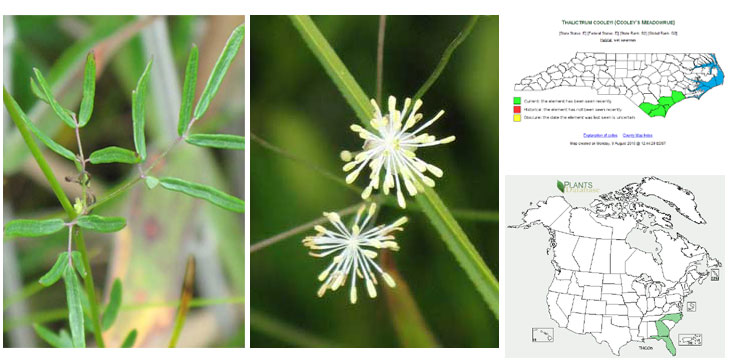

Habitat of Thalictrum cooleyi (Photo: Krings)

Habit of Thalictrum cooleyi (Photo: Krings)

Habit of Thalictrum cooleyi (Photo: Krings)

Compound leaves of Thalictrum cooleyi (Photo: Krings)

Leaves of Thalictrum cooleyi (Photo: Krings)

Female flowers of Thalictrum cooleyi (Photo: Krings)

Male flowers of Thalictrum cooleyi (Photo: Krings)
Thalictrum cooleyi* (rare [Fed E, S1 G1]; ecotones between calcareous savannas and adjacent swamp forests; CP; summer)
1’. Leaflets of the stem leaves ovate, obovate, or suborbicular, 0.7–3 (–5) x as long as wide...2.
2. Inflorescence umbellate... T. thalictroides 
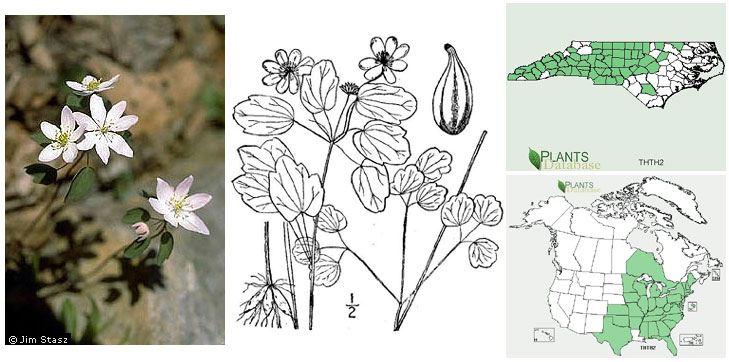

Leaves of Thalictrum thalictroides (Photo: Krings)

Thalictrum thalictroides (Photo: Krings)

Thalictrum thalictroides (Photo: Krings)

Umbel of Thalictrum thalictroides (Photo: Krings)

Thalictrum thalictroides (Photo: Krings)

Thalictrum thalictroides (Photo: Krings)

Thalictrum thalictroides (Photo: Krings)
Thalictrum thalictroides (common; moist forest; Mt, Pd, CP [rare])
2’. Inflorescence paniculate...3.
3. Achene scimitar-shaped; flowers perfect...T. clavatum 
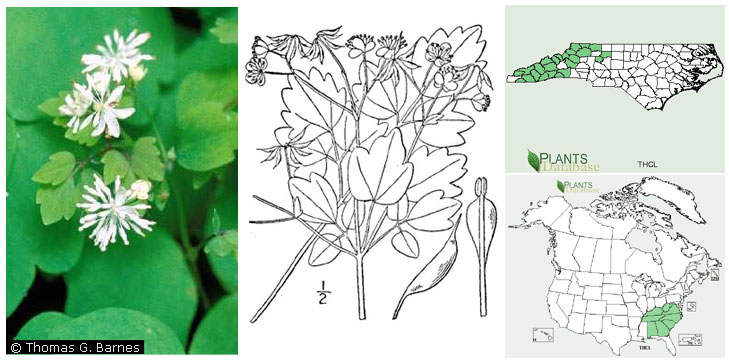

Thalictrum clavatum (Photo: Krings)

Thalictrum clavatum (Photo: Krings)

Thalictrum clavatum (Photo: Krings)

Thalictrum clavatum (Photo: Krings)

Thalictrum clavatum (Photo: Krings)

Thalictrum clavatum (Photo: Krings)

Thalictrum clavatum (Photo: Krings)
Thalictrum clavatum (common; seepages, moist forests, spray cliffs; Mt, Pd [rare], CP [rare])
3’. Achene not scimitar-shaped; flowers unisexual or sometimes a few bisexual...3.
4. Most leaflets with (3–) 4–6 (–9) lobes or teeth...5.
5. Cauline leaf subtending the lowest flowering branch sessile; plant flowering May–Jul...T. coriaceum 
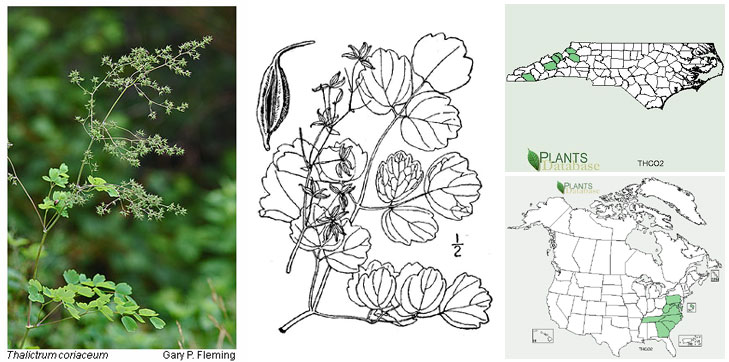

Thalictrum coriaceum (Photo: Krings)

Thalictrum coriaceum (Photo: Krings)

Thalictrum coriaceum (Photo: Krings)

Thalictrum coriaceum (Photo: Krings)

Thalictrum coriaceum (Photo: Krings)

Thalictrum coriaceum (Photo: Krings)

Thalictrum coriaceum (Photo: Krings)
Thalictrum coriaceum (uncommon; rich forests; Mt)
5’. Cauline leaf subtending the lowest flowering branch with a petiole 3–7 cm long; plant flowering Mar-Apr
...T. dioicum 


Thalictrum dioicum (Photo: Krings)

Thalictrum dioicum (Photo: Krings)

Thalictrum dioicum (Photo: Krings)

Thalictrum dioicum (Photo: Krings)

Thalictrum dioicum (Photo: Krings)

Thalictrum dioicum (Photo: Krings)

Thalictrum dioicum (Photo: Krings)
Thalictrum dioicum (common; seepages, moist forests; Mt, PD, CP [rare])
4’. Most leaflets with 1–3 (–5) lobes or teeth...6.
6. Abaxial leaflet surface, peduncles, and achenes with stipitate glands or papillae...7.
7. Anthers 0.5–1.2 mm long; stigmas 0.6–2.2 mm long...T. pubescens var. hepaticum 
 Thalictrum pubescens
Thalictrum pubescens var.
hepaticum (rare; seepages; Mt)
Note: Mapped range is for
T. pubescens complex, not simply var.
hepaticum. See note above.
7’. Anthers 1.5–2.8 mm long; stigmas (1.5–) 2.0–3.5 mm long...T. revolutum 


Thalictrum revolutum (Photo: Krings)

Thalictrum revolutum (Photo: Krings)

Thalictrum revolutum (Photo: Krings)

Thalictrum revolutum (Photo: Krings)

Thalictrum revolutum (Photo: Krings)

Thalictrum revolutum (Photo: Krings)

Thalictrum revolutum (Photo: Krings)
Thalictrum revolutum (common; mesic to dry forests, barrens, and glades; Mt, Pd,CP [rare])
6’. Abaxial leaflet undersurfaces, peduncles, and achenes glabrous or pubescent, but lacking both stipitate glands and papillae...8.
8. Abaxial leaflet surfaces, peduncles, and achenes finely pubescent...T. pubescens var. pubescens 
 Thalictrum pubescens
Thalictrum pubescens var.
pubescens (common; bogs, marshes, wet forests; Mt, Pd [rare], CP [rare])
Note: Mapped range is for
T. pubescens complex, not simply var.
pubescens. See note above.
8’. Abaxial leaflet surfaces, peduncles, and achenes glabrous...9.
9. Leaflets entire to 3-lobed, largest usually < 22 mm wide; filaments (2–) 3–4.5 (–6.5) mm long...T. macrostylum 
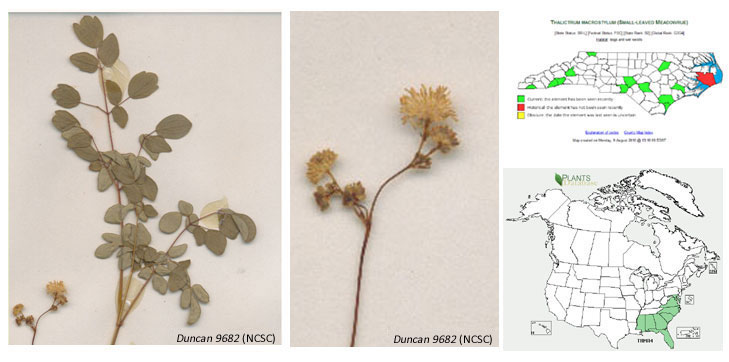 Thalictrum macrostylum
Thalictrum macrostylum
(rare [State SC-V, S2 G3G4]; moist places, ultramafic outcrop barrens, tidal freshwater marshes; Mt, Pd, CP)
9’. Leaflets 3-lobed (rarely entire), largest usually 15–60 mm wide; filaments (2–) 4–5 (–8) mm long...10.
10. Anthers 0.5–1.2 mm long; stigmas 0.6–2.2 mm long...T. pubescens var. hepaticum 
 Thalictrum pubescens
Thalictrum pubescens var.
hepaticum (rare; seepages; Mt)
Note: Mapped range is for
T. pubescens complex, not simply var.
hepaticum. See note above.
10’. Anthers 1.5–2.8 mm long; stigmas (1.5–) 2.0–3.3 mm long...T. revolutum 


Thalictrum revolutum (Photo: Krings)

Thalictrum revolutum (Photo: Krings)

Thalictrum revolutum (Photo: Krings)

Thalictrum revolutum (Photo: Krings)

Thalictrum revolutum (Photo: Krings)

Thalictrum revolutum (Photo: Krings)

Thalictrum revolutum (Photo: Krings)
Thalictrum revolutum (common; mesic to dry forests, barrens, and glades; Mt, Pd,CP [rare])











